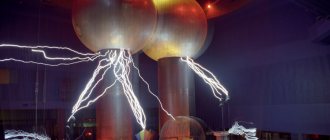Situations with power outages or lack of power supply make you think about a backup power source. Good solution to the problem – buy or make a gas generator with your own hands.
Among all existing generators, gasoline is in first place in popularity.
What are they good for?
- Easy to use;
- Compact and mobile;
- They have high productivity;
- Easy to repair;
- The price is cheaper than diesel generators.
Gasoline generators are used during emergency shutdowns as a replacement for a current source .
They help out owners of dachas and construction sites where power has not yet been supplied, and provide a decent living for geologists, rangers, reindeer herders, drillers - everyone who is forced to work in hard-to-reach areas. A good assistant for home craftsmen in the country or in the garage. They make it possible to replace manual labor with mechanized labor even where the use of electricity is not available. Lighting, electrical appliances and tools, and household appliances are connected through the generator. When connecting devices,
pay attention to the permissible voltage - if the generator is designed for 127 Volts, then devices manufactured for 220 Volts will not be able to operate with the declared power.
The uninterrupted operation time of a gas generator depends on the power of the device, the volume of the fuel tank, and the load size. There are models that can provide operation under load for up to one and a half thousand hours.
Operating tips: what difficulties may arise
A common problem with generator operation is power overload. This causes intense heating of the winding and breakdown of the insulation. As a result, the generator breaks down. Occurs due to:
- Incorrect selection of capacitor bank capacity;
- Connecting a large number of electrical equipment, the total power of which exceeds the rated power.
We have already discussed the rules for selecting containers and calculations above. And regarding the problem of power overload in a three-phase generator, it is necessary to note some more nuances when connecting single-phase consumers:
- Consumers with a voltage of 220 Volts can only be connected to one third of the total power (for example, if a generator produces 6 kW, then this is only for 380 Volt devices, and for single-phase devices it will be only 2 kW, no more). Otherwise, there will be an overload.
- If your generator has two single-phase lines, then together the power through them will be 2/3 of the total power. That is, 6 kW is 4 kW for single-phase, 2 kW for each phase. Moreover, when using phases at the same time, make sure that the load does not differ from the power by up to 10%, otherwise the phenomenon of “phase imbalance” will occur and no current will flow.
When working, it is important to monitor the AC frequency indicator. If you have not built a frequency meter into the common electrical panel, then at idle the output voltage is 4–6 percent higher than 380 Volts (or 220 when connecting single-phase ones).
Device
The operating principle of a gasoline generator is based on the conversion of energy obtained from the combustion of gasoline into electrical energy . Components of a gas generator:
- Gas engine;
- Electric motor 127, 220 or 380 V;
- Fuel tank;
- Starter;
- Capacitors;
- Electrical circuit breakers and switches;
- Voltmeter;
- Sockets for connecting electrical appliances.
Industrial models are equipped with additional functions that allow you to control all operating parameters. ATS (automatic input of backup power in emergency situations) is especially convenient. The entire device is mounted on a convenient rigid frame equipped with wheels and handles for transportation. The factory casing is much more beautiful and stronger than the homemade one. Below is a drawing showing all the parts of a gasoline generator.
For those who are well versed in electrical engineering and know how to work with their hands, making a gas generator with your own hands
is not difficult .
Generator operating principle
The operation of a gasoline generator to generate electricity is based on the phenomena of electromagnetic induction, which were studied in a school physics course. The bottom line is that a conductor passes through an electromagnetic cloud and receives an impulse, which is subsequently processed into a constant current. All operations follow one another:
One of the components of the generator is the engine. Its task is to generate electricity by burning fuel, most often gasoline or diesel fuel.- The burned fuel produces combustion products, that is, gas, under the pressure of which the crankshaft begins to rotate.
- The purpose of the crankshaft is to transmit an impulse to the driven shaft, which provides a certain amount of electrical energy at the output.
The overall picture is clear, but it is necessary to understand that a positive result is guaranteed only if the calculations and connections of the main structural parts are carried out correctly.
Generators come in different capacities. The consumption of fuel resources is also different. But, regardless of the listed parameters, two components are fundamental: the rotor and the stator. The armature is used to create electromagnetic fields , which is why it consists of magnets equidistant from the core. The purpose of the stator is to drive the rotor and regulate the state of electromagnetic fields.
Where to begin?
Based on the magnitude of the required loads to simultaneously turn on the devices, all the main elements are selected.
Optimal performance indicators are achieved by correctly selecting the power of gasoline and electric engines.
To obtain a single-phase current of 220 V, a two-stroke gasoline engine is suitable, and if you plan to obtain higher powers, then the choice should be made on a four-stroke. Fuel consumption will depend on the selected engine. In addition to the main task - generating energy, a system for noise reduction, lubrication, ventilation, and installation of an exhaust pipe for removing gases should be provided. You will have to buy wheels to ensure the mobility of the device. The casing can be made of metal or plywood.
Scope of application
The undoubted advantages of the gas generator provide it with a wide range of applications:
- during construction and installation works;
- at production sites and repair shops;
- in emergency lighting systems;
- for household work in areas where electricity has not yet been supplied;
- for organizing picnics;
- when providing emergency power supply to hospitals;
- for backup power supply in private cottages.
Gasoline generator in operation
The simplest gas generator
As an example, let’s look at a simple homemade design based on a chainsaw and an electric motor from an old washing machine:
- We attach the electric motor from the washing machine to the chainsaw bar using a specially made stable bracket.
- We put pulleys on the drive shafts of both engines and connect them using a belt drive.
- The button for adjusting the speed of the chainsaw engine, located on the handle, is equipped with an additional device for adjusting the pressing force. A simple bolt secured with a clamp will do the job just fine. To increase the speed, it will be enough to tighten it, and to decrease it, loosen it.
- We connect two capacitors in parallel to the external starting winding of the electric motor, designed for a power of 400-450 Volts.
The video shows a generator with a washing machine engine
This installation, the simplest in its design, is capable of delivering a current of 220 V 180 A , which is enough to power a drill, screwdriver, and lighting fixtures.
Almost any craftsman can make such a basic device. Of course, except for cases when a person does not see the difference between an engine and a carburetor, or the words bracket and container sound the same to him. It is completely unacceptable to manufacture electrical appliances for a person who does not know the differences between the concepts of power (watt), current (ampere) and circuit voltage (volt). More complex designs require fundamental knowledge and skills that will help to correctly calculate engine power, ensure safe use of the finished design, and correctly configure all parameters.
Operating principle of an asynchronous electric motor
When the supply voltage is connected to the stator, current flows through the turns of the winding. It creates a magnetic field inside. Since the current is alternating, the field changes in accordance with the shape of the supply voltage. The arrangement of the windings in space is made in such a way that the field inside it turns out to be rotating. In the rotor winding, the rotating field induces an emf. And since the turns of the winding are short-circuited, a current appears in them. It interacts with the stator field, this leads to rotation of the electric motor shaft.
An electric motor is called an asynchronous motor because the stator field and the rotor rotate at different speeds. This speed difference is called slip (S). where: n – magnetic field frequency; nr – rotor rotation frequency. To regulate the shaft speed over a wide range, asynchronous electric motors are made with a wound rotor. On such a rotor, windings displaced in space are wound, the same as on the stator. The ends from them are brought out onto rings, and resistors are connected to them using a brush apparatus. The greater the resistance connected to the phase rotor, the lower its rotation speed will be.
Pros and cons of a homemade unit
pros
- The ability to “extend the life” of old engines;
- If repairs are necessary, there will be no difficulties - you know every screw of the design;
- Increased self-esteem - a successfully manufactured functional device will become a source of pride for you;
- Possibility to use as food when carrying out welding work;
- Saving money, replacing manual labor with a more progressive one.
Minuses:
- The process is labor intensive; many operations require special tools and premises.
- When making devices at home, many functions present in industrial designs are omitted.
- If old parts are not available, then purchasing new ones in stores can be too expensive.
- There is no possibility of connecting an ATS (automatic transfer switch).
A homemade gas generator can be a good alternative to factory models in cases where there is not enough money to purchase it or the need for its use arises infrequently. For constant and regular use, it is better to purchase a ready-made gas generator for 220 or 380 Volts with a factory warranty. Unless, of course, remaking various devices and fixtures is your favorite pastime. And it is advisable that you have skills in various jobs - you will need a lot of manual operations, welding and installation work.
Let's make an electric generator with our own hands
Local power grids are not always able to fully provide electricity to homes, especially when it comes to country houses and mansions. Interruptions in the constant power supply or its complete absence forces us to look for alternative ways to obtain electricity. One of these is the use of an electric generator - a device capable of converting and storing electricity, using the most unusual resources (energy from the sun, wind, tides). Its operating principle is quite simple, which makes it possible to make an electric generator with your own hands. A homemade model may not be able to compete with a factory-assembled analogue, but this is a great way to save more than 10,000 rubles. If we consider a homemade electric generator as a temporary alternative source of power supply, then it is quite possible to get by with a homemade one.
How to make an electric generator, what is required for this, as well as what nuances will have to be taken into account, we will find out further.











